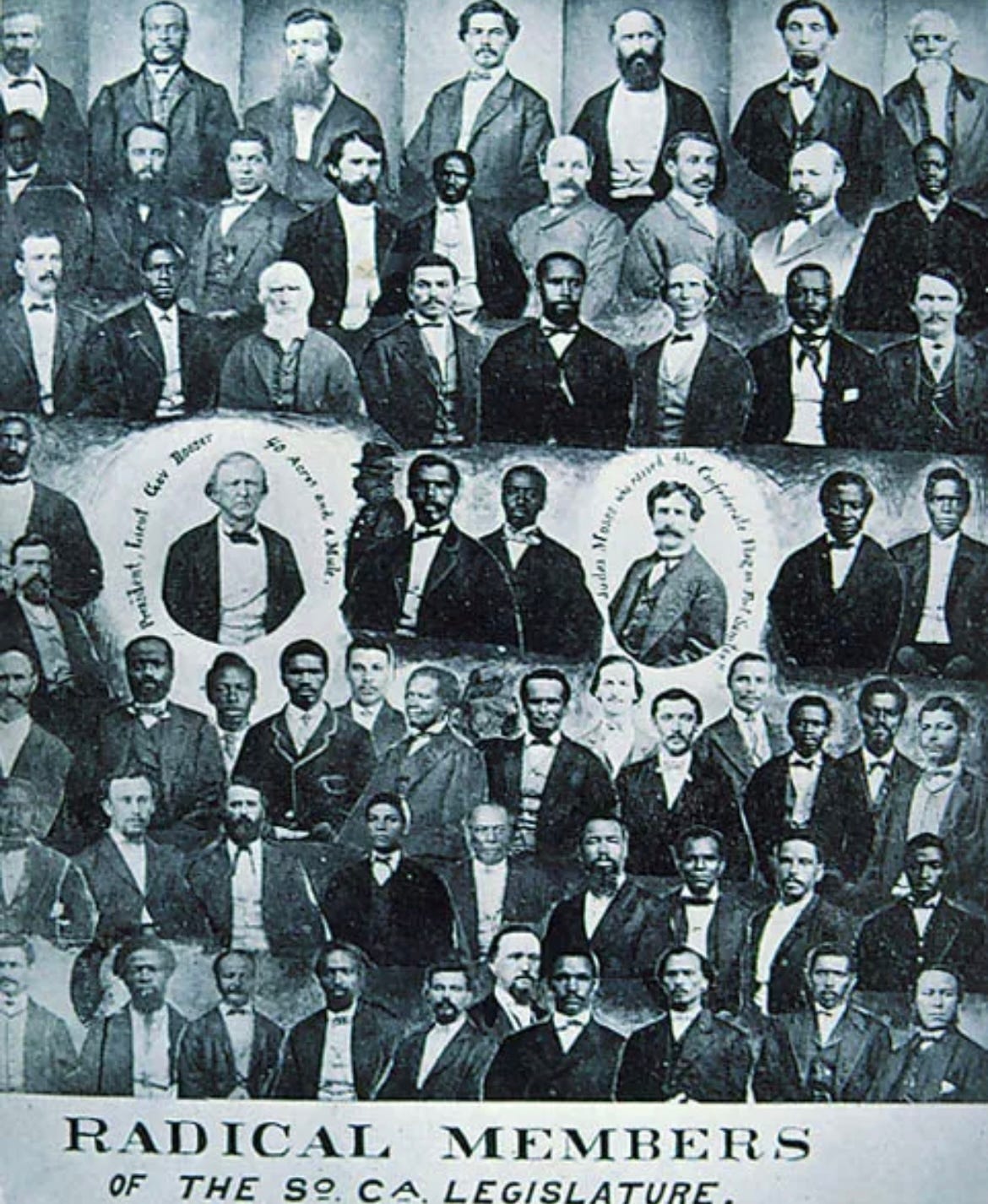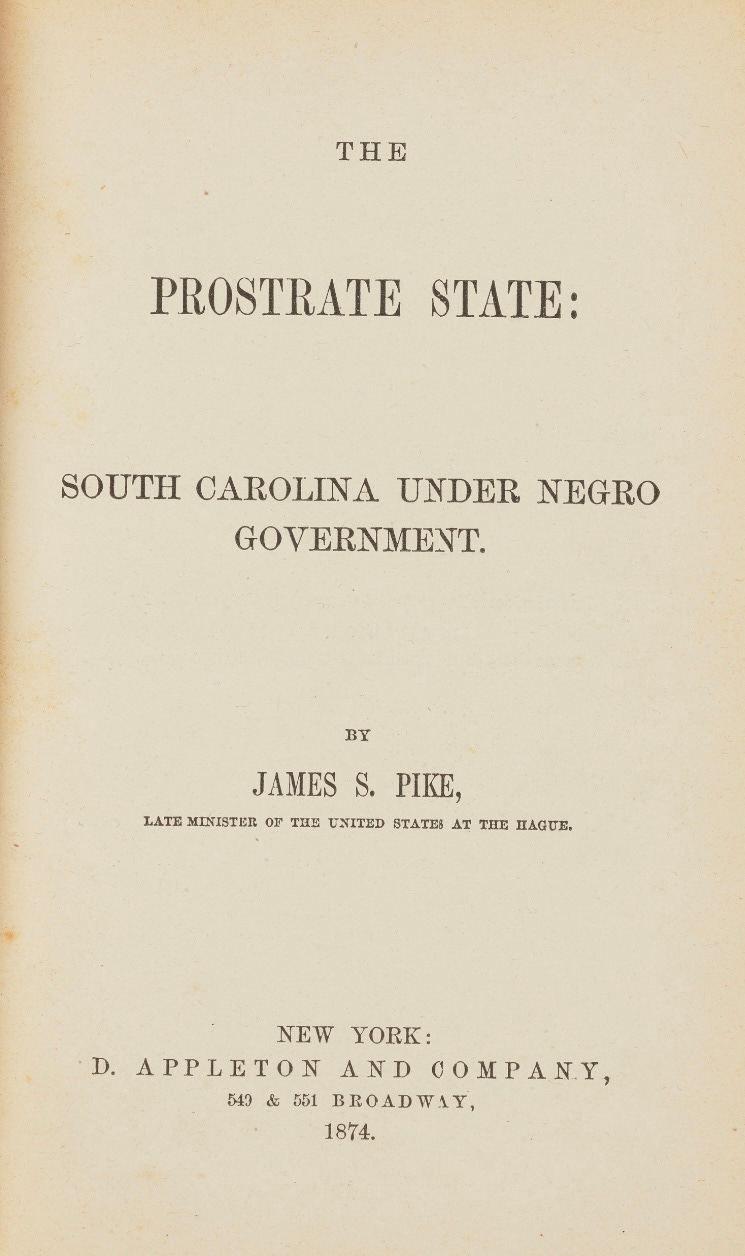A tragic plane crash kills scores of Americans.
The response, online within minutes and by Trump, within hours—“DEI!”
A ship collides with a bridge in Baltimore, killing workers and disabling a major highway.
The response—“DEI!”
Wildfires destroy communities with the whole nation watching.
“DEI!”
This Trumpian refrain that every problem in government (even tragedies) is due to “DEI”—which is clearly code for anyone who’s not a white male being in important (or any) positions of government—may feel like a recent trend.
The truth is, the response is not new at all.
And I’m not talking about the fact that the “DEI” attack follows equally fierce attacks on “woke” and “CRT.”
I’m talking about a long and dark pattern of American history.
Specifically, it bears a striking resemblance to the period when white supremacist forces who called themselves “Redeemers” crushed the multi-racial governments that emerged amid Reconstruction, leading to Jim Crow.
It’s one of the most disturbing eras in American history.
So the fact that what happened then bears such similarities to what’s happening today should disturb the hell out of us. And teach us a key lesson.
Quick Recap
Without going through all the details, the XIII, XIV and XV Amendments changed the nation, and the South in particular. When combined with other Congressional actions as well as a president (Ulysses Grant) willing to enforce them, a surge in Black participation in Southern politics revolutionized politics, democracy and the makeup of state and local governments across former Confederate states.
Newly enfranchised Black voters registered and voted in huge numbers—in some states, more than white voters. Southern Black turnout for presidential elections reached 60%. And from that diverse electorate, Black candidates won offices across Southern states—from local, to state legislative (in some states, making up a majority of the legislature and speakers of houses), to statewide, to federal offices (at least one Black member of Congress from the South for decades).
Local governments also saw a new generation of Black leaders in prominent positions: “Black justices of the peace, Black magistrates, carpetbagger sheriffs—all sorts of unmentionable people began to be elected to positions of considerable local power.”
For a short period, government actually reflected the diversity of the Southern electorate. White and Black Americans together led and served at all levels.
Government services such as education reflected this multiracial revolution: “Black children were being educated in free public schools paid for by local property taxes. White supremacists were horrified by this.”
…But “The Redeemers” Fight Back
But in a pattern that replays itself over the course of American history, the backlash to this new, multi-racial democracy and government was fierce.
The two most blunt-force instruments that emerged were outright violence, along with devices to eliminate Black participation in elections—poll taxes, “character” and literacy tests, “grandfather clauses,” discriminatory primaries, and other steps.
But behind the violence and the suppression was a consistent theme advanced by those trying to topple these new, diverse Southern governments. A theme justifying it all—allowing a movement called “Redemption” to frame these actions as righteous and high-minded reform. And if you listen closely, it’s this theme that will sound so familiar.
Here’s a letter that spells it out: “Our condition here under negro rule is horrible…Negroes here speak openly and boldly of social equality, and discuss it all in its various forms….”
Just as “DEI” is now bandied about as a catch-all, “Redeemers” summed up their challenge then as “the Negro Problem.”
And that “problem,” they argued, was that Blacks (again, in the majority, and working in multi-racial coalitions) were simply unqualified and incapable of governance. The presence of Blacks in government was sullying government at all levels—cities and new schools and state governments— and the South writ large, and they needed to be removed. The prior all-white South needed to be “redeemed.”
As one paper explains, “they paid special attention to African Americans in position of power.” Whites pushing this “felt blacks were corrupt and therefore should not hold a respectable position, like government office. On the other hand, whites exerted the honor and respect worthy of maintaining such positions. These ideas formulated into a growing belief that removing blacks from the political process would simultaneously clean up democracy.”
And their target were Blacks serving at all levels of government: “the Redeemers argued that ‘as a consequence of turning these local offices over to the negroes, bad government has followed.’”
In addition to removing Blacks from power and posts, the Redeemers “consistently sought to limit local power, curtail local democracy, and defund or eliminate local services.”
“The idea was that as long as government was even partially subject to multiracial control—and even partially being used to redistribute wealth, power, and privilege—the Redeemers could limit that capacity by starving state and local governments of the funds they needed.”
“The core logic at work was the core logic of Redemption: the only legitimate government (and government services) were those that obeyed the orthodoxy of white supremacy. The corollary logic that animated retrenchment was that no government (and no government services) was preferrable to a multiracial government and the redistribution that it threatened or promised.”
As a result of this frame, Redeemers “waged a thirty-year attritional war to blunt, mute, and ultimately snuff out the power and voice of Black voters across the South.” In another theme similar to today, much of the attack on Black voters was justified on a myth of widespread voter fraud by those new Black voters.
Later accounts, such as the movie Birth of the Nation, carried this narrative well into the 20th century: “African Americans in the South were depicted as powerful enough to gain control of the political economy, but they were simultaneously portrayed as buffoons—uppity and incapable of self-rule.”
Beyond gaining strong political support from Southern whites, as well as the overlay of violence, two other key factors allowed the movement to succeed.
First, despite the new Amendments and laws, the US Supreme Court let it all happen in a series of horrific cases in the late 1800s and early 1900s.
And second, over time, far too many Northern whites accepted the “Redeemer” premise. The framing of Reconstruction as a failed experiment because Blacks were unqualified and unprepared to be in government became a narrative the country largely accepted—such that Northern politicians stopped fighting for Black political rights or equality in the South. It became so ingrained, Woodrow Wilson hosted a White House screening of Birth of a Nation—the movie that told the “Redeemer” story as a heroic one—when it came out and was celebrated nationwide.
In the end, all of it worked.
Over time, the number of registered voters in Louisiana plummeted from its high of 128,000 in the 1870s to 700 in 1910.
700!
In Mississippi, from 53,000 to 3,000.
In Alabama, from 140,000 to 3,000.
Similar declines elsewhere.
Southern Black turnout in presidential elections fell from that peak of 60%, down to 2%.
And with almost no Black voters remaining, those new multiracial governments—all those Black elected officials at all levels of government from not long before—were wiped out. And would remain wiped out for generations, as white-only governments enacted Jim Crow laws and a system of racial apartheid for generations.
Over time, the fact that there were even multi-racial governments at all in the late 1800s was erased from history. Most are still shocked by photos like the on above.
The Modern Day “Redeemers”
Horrible, right?
Now think about today.
The rhetoric. The actions. What’s playing out at this moment.
She went to Harvard and Harvard Law School, where she graduated cum laude, and went on to clerk for the Supreme Court before serving as both a federal district and appellate judge following bipartisan support. But once appointed to the US Supreme Court, Justice Ketanji Brown Jackson was quickly dismissed as the “DEI Justice.” And still is.
Mayor Brandon Scott was one of the youngest people ever elected to Baltimore’s City Council, served eight years, then rose to Council president. After beating the incumbent Mayor in a primary, then winning the general election in a landslide in November, he was elected Mayor of Baltimore in 2020. (This is far greater experience than, say, JD Vance). But when a barge hit a bridge in the Baltimore harbor, he was instantly labeled the “DEI Mayor.” The accident was due to “DEI,” people charged.
When she took the firefighter exam in 1998, Kristin Crowley finished in the top 50 out of more than 16,000 applicants. Since joining the department in 2000, she has held the roles of firefighter, paramedic, engineer, fire inspector, captain, battalion chief, assistant chief, fire marshal and deputy chief. She was appointed LA’s fire chief in 2022. When tragic wildfires hit LA in January, Crowley was the “DEI” Chief.
Folks, when they attack DEI, they are not talking about programs.
They are talking about people in leadership. And regardless of credentials, if those people are not white men, the “DEI” moniker immediately thrown as a weapon, even (and especially) after tragedy.
This consistent response makes it clear that they think leaders who are not white men are simply not qualified to be there. In their world, Justice Jackson is a “DEI Justice,” but conspiracy theorist RFK is fit to lead, and drunk and abusive Pete Hegseth is a great pick. That differential treatment comes right out of the “Redeemer” mindset (quote from above): “blacks were corrupt and therefore should not hold a respectable position, like government office. On the other hand, whites exerted the honor and respect worthy of maintaining such positions.”
And just like the Redeemers upended an entire democracy to root out Black involvement (their so-called “Negro problem”), that’s what they’re doing here.
Right now.
No surprise, the first firings of the federal government are “DEI” firings—meaning that workers of color and women will be the ones disproportionately escorted out of buildings. Yes, just as Redeemers “felt blacks were corrupt and therefore should not hold a respectable position, like government office.”
And just like they were willing to defund local government to clamp down on multi-racial government, they’re doing the same now at the federal level. The spending freeze that caused so much chaos last week is justified as necessary to root out “DEI” wherever it exists.
University “DEI” attacks are of the same nature—targeting subject matters and work that pertain to Americans of color and women, along with a disproportionate impact on the careers of people of color and women. As the Redeemer letter above complained: “Negroes here speak openly and boldly of social equality, and discuss it all in its various forms….” The right is fighting the same battle today.
And now state Attorneys General are in court trying to stop private companies from pushing for equity. The Redeemers would surely be impressed.
What NOT to do
So the parallels are scarily similar. Something all Americans should see and understand.
What are the lessons?
Many, but let me share one in particular.
As I was thinking through these parallels, I also watched the national press and commentators respond to one of the DNC sessions over the weekend. Apparently, the speakers at one session were emphasizing the importance of diversity. And the media commentators pounded, essentially saying: “have they learned nothing? That is a losing issue! They need to give that up!”
And all I could think about was that beyond a complicit Court, the other key factor that allowed the Redeemers to win (ultimately, for generations) was that former allies in the North gave up. They too gave up on multi-racial, inclusive democracy as not worth fighting for. And over time, they even bought into the Redeemers’ narrative.
That moment of acceptance—of abandonment—is what truly locked Jim Crow in for so long. It what’s doomed generations of Black Southerners to being trapped in a world of white supremacy. It’s what doomed the entire nation from being a true democracy all that time.
So of course there is so much those fighting for an inclusive democracy can do to improve our message. Our tactics. Our strategies. Who leads.
But do NOT get bullied into ceasing to stand strong for equality and equal rights. History tells us the damage from that decision would be deep and long lasting.
Day 63 — February 2, 2025
Counter to his campaign message, and in the wake of his unilateral tariffs, Trump told Americans that they may experience “pain” from his policies, but that that pain is a “price that must be paid.”
Elon Musk and his amorphous and undefined team of private individuals at DOGE have gained access to critical data systems of the federal government, including Department of Treasury data that includes all Americans' social security, tax, Medicare, and other financial information, as well as data from the Office of Personnel Management, the General Services Administration, and USAID.
Musk also is using this access to shut down payments to federal contractors.
Given all this, not a single Democratic Senator should vote for a single nominee to this Cabinet from this point on. The new Treasury Secretary and Secretary of State (who both received broad Democratic support) have already gone along with the DOGE/Trump agenda.
Every vote at this point is cover, present and future, for what is happening.
Democrats should be laser focused on a unified plan to stop this—and should play no role in advancing any of it.














Share this post